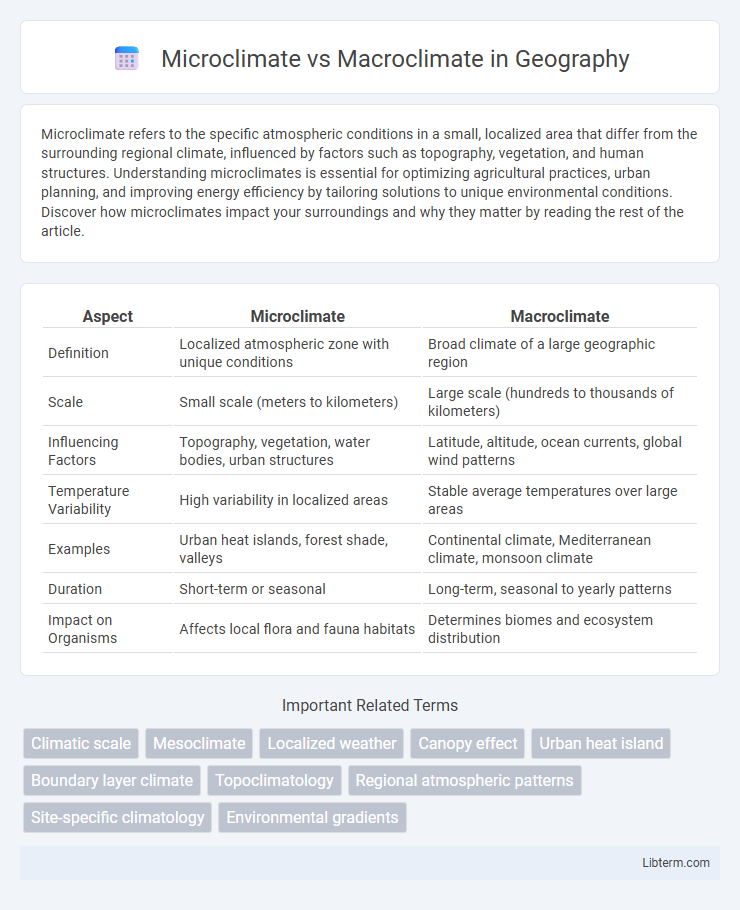Microclimate refers to the specific atmospheric conditions in a small, localized area that differ from the surrounding regional climate, influenced by factors such as topography, vegetation, and human structures. Understanding microclimates is essential for optimizing agricultural practices, urban planning, and improving energy efficiency by tailoring solutions to unique environmental conditions. Discover how microclimates impact your surroundings and why they matter by reading the rest of the article.
Table of Comparison
| Aspect | Microclimate | Macroclimate |
|---|---|---|
| Definition | Localized atmospheric zone with unique conditions | Broad climate of a large geographic region |
| Scale | Small scale (meters to kilometers) | Large scale (hundreds to thousands of kilometers) |
| Influencing Factors | Topography, vegetation, water bodies, urban structures | Latitude, altitude, ocean currents, global wind patterns |
| Temperature Variability | High variability in localized areas | Stable average temperatures over large areas |
| Examples | Urban heat islands, forest shade, valleys | Continental climate, Mediterranean climate, monsoon climate |
| Duration | Short-term or seasonal | Long-term, seasonal to yearly patterns |
| Impact on Organisms | Affects local flora and fauna habitats | Determines biomes and ecosystem distribution |
Introduction to Microclimate and Macroclimate
Microclimate refers to the localized atmospheric conditions in a specific area, such as a garden, urban neighborhood, or forest patch, influenced by factors like terrain, vegetation, and human structures. Macroclimate describes the broader climate patterns across large regions or continents, governed by global and regional atmospheric phenomena including latitude, altitude, and prevailing wind systems. Understanding microclimates is essential for agriculture, urban planning, and ecosystem management, while macroclimate provides context for long-term weather trends and climatic zones.
Defining Microclimate: Key Characteristics
Microclimate refers to the localized atmospheric conditions that differ from the surrounding regional climate, typically influenced by factors such as terrain, vegetation, and man-made structures. Key characteristics include variations in temperature, humidity, wind patterns, and solar radiation within a limited area, often spanning just a few meters to several kilometers. These small-scale climate variations significantly impact plant growth, wildlife habitats, and human comfort in urban and rural settings.
Understanding Macroclimate: Broad-Scale Influences
Macroclimate refers to the climate patterns that prevail over large geographic areas, such as regions, countries, or continents, influenced by factors like latitude, altitude, ocean currents, and prevailing wind systems. These broad-scale influences shape temperature ranges, precipitation patterns, and seasonal variations that define the overall weather conditions experienced in extensive zones. Understanding macroclimate is essential for ecological research, agriculture planning, and climate change assessments because it provides contextual climate trends against which localized microclimates operate.
Major Differences Between Microclimate and Macroclimate
Microclimate refers to localized atmospheric conditions within a small, specific area such as a garden or urban park, often influenced by vegetation, buildings, and topography. Macroclimate encompasses broader regional or global climate patterns shaped by large-scale factors like latitude, altitude, and prevailing wind systems. Key differences include spatial scale--with microclimate impacting meters to kilometers and macroclimate covering hundreds to thousands of kilometers--and temporal variability, as microclimates exhibit short-term changes while macroclimates reflect long-term climate trends.
Factors Influencing Microclimates
Microclimates are influenced by factors such as topography, vegetation, water bodies, and urban structures, which create localized climate variations distinct from broader macroclimate regions. Soil type and land use also play crucial roles in altering temperature, humidity, and wind patterns within small areas. These elements combine to shape microclimates that can significantly affect plant growth, wildlife habitats, and human comfort.
Elements Shaping Macroclimates
Macroclimates are shaped by large-scale elements such as latitude, altitude, and prevailing wind patterns, which influence temperature, humidity, and precipitation over expansive geographic regions. Ocean currents and continentality also play critical roles in determining regional climate characteristics by affecting heat distribution and moisture availability. These factors collectively define the broader climate zones, contrasting with microclimates that arise from localized conditions influenced by features like vegetation, topography, and urban structures.
Impact of Microclimate on Local Ecosystems
Microclimate significantly influences local ecosystems by creating unique temperature, humidity, and light conditions that diverge from the broader macroclimate, enabling diverse species to thrive in specific niches. Variations in microclimate, caused by factors like vegetation cover, topography, and urban structures, can affect plant growth, animal behavior, and soil moisture levels, directly shaping biodiversity and ecological interactions. Understanding microclimate effects is essential for conservation strategies and habitat restoration, as it determines resource availability and resilience to climate change at a localized scale.
Macroclimate and Its Role in Global Climate Patterns
Macroclimate refers to the climate patterns observed over large geographic areas such as regions, countries, or continents, influencing broad environmental conditions and ecosystems. It plays a crucial role in shaping global climate patterns by regulating temperature distributions, precipitation cycles, and atmospheric circulation on a planetary scale. Understanding macroclimate dynamics is essential for predicting long-term climate trends, assessing climate change impacts, and developing sustainable environmental policies.
Practical Examples: Microclimate vs Macroclimate
Microclimate refers to the localized atmospheric conditions within a small area, such as the cooler shade beneath a tree or the warmth retained by urban heat islands, while macroclimate describes broader regional or global climate patterns like the Mediterranean or tropical climates. Practical examples include a vineyard that benefits from a microclimate where temperature variations protect grapes from frost, contrasting with the macroclimate of the wider wine-producing region. Urban planners and farmers use microclimate data to optimize crop placement and building designs, tailoring strategies to the specific microclimate rather than relying solely on regional macroclimate averages.
Importance of Climate Scales in Environmental Planning
Microclimate affects localized conditions such as temperature, humidity, and wind patterns within small areas like urban parks or building surroundings, influencing vegetation health and energy consumption. Macroclimate represents broader regional climate trends, including prevailing weather systems and seasonal variations, crucial for long-term environmental policies and land use planning. Integrating microclimate and macroclimate data supports precise environmental planning, enabling adaptive strategies for sustainability, disaster resilience, and resource management.
Microclimate Infographic

 libterm.com
libterm.com